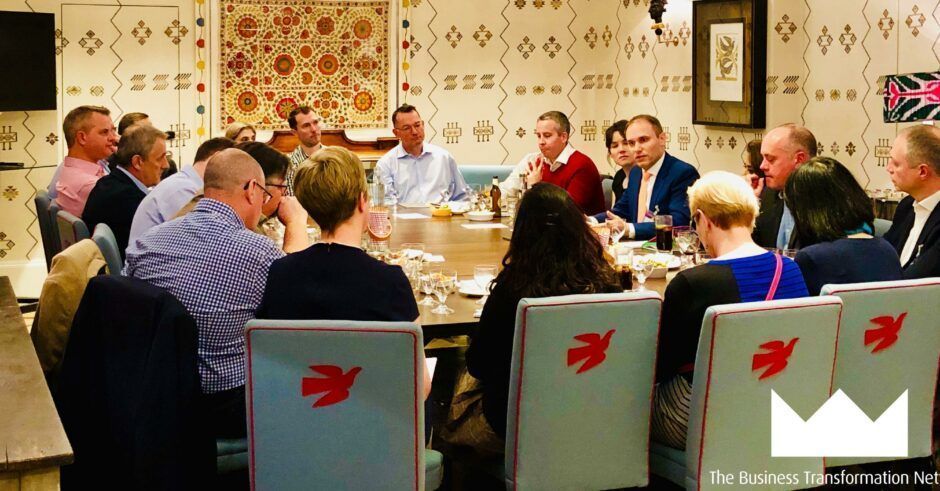Recently, The Business Transformation Network hosted an event on “HR TechOps – Bridging the Gap between HR Tech and Operational Excellence”, which is a topic of growing importance in business today. The main questions the conversation revolved around were:
1. What HR Technology platforms are being implemented and how is the implementation process going?
2. How can HR technology be used to improve efficiency and employee experience?
3. Advice for any business undergoing a business transformation
What HR Technology platforms are being used amongst attendees? What commentary would people have around implementation process?
Many organisations are experiencing a digital transformation of some form, including HR Technology implementation and the implementation process for this, but ‘only 12% of employees are satisfied with the impacts of the average digital transformation.’ This was reflective of the feelings of the attendees and their own place of work, with this theme of dissatisfaction with digital transformation running throughout the conversations.
All attendees were either currently going through a transformation or had recently completed one, with almost all of our guests implementing either SAP SuccessFactors or Workday.
Post-implementation evaluation is vital to transformation projects and the discussion moved to looking at whether there was a gap between HR Technology and Operational Excellence.
It soon became evident that there is definitely a gap to be bridged, with many citing that a lack of customisation within the technology led to clashes with their existing processes and company cultures. It was apparent that lacking communication, and poorly defined goals were universally seen as an issue within most transformation. Some people went as far as to say that HR leaders needed to take a hard look in the mirror, and articulate more definitively the purpose of HR in modern business, before they engage in expensive transformations programmes. There was a feeling that because HR’s goals had a lack of clarity, things were almost set up to fail from the beginning, with technology providers being poorly educated on what the specific needs of a modern HR function should be.
There was a great deal to learn about the technology industry and how the software functions. They observed that senior stakeholders, both in HR and the wider business, felt that they were buying a tool with almost infinite potential to fit into their current business models, rather than purchasing new processes which they should adapt themselves and their organisation around.
How can we best use the selection of HR Technology and the process of implementation to improve both effectiveness and the user experience of employees?
One of the main problems identified was that whilst stakeholders were keen to introduce new technology and processes, many were reluctant to change the job descriptions of employees, even if new technology could fundamentally change the responsibilities of a particular role. More than just a culture or HR process change – the Operations & Technology leaders felt stakeholders should be braver when telling employees at large that their role would transform as well.
In order to best evaluate whether an implementation was successful or worth the investment, there needs to be a shift in the way stakeholders measure ROI, but there was not a general consensus on which it should be: Savings? User experience surveys? Or something completely different altogether?
For example, shared frustrations were voiced with employees ignoring the new functionality of the system, with many employees defining their most important criteria for an improved UX as being ‘flashier’ aesthetics, scrolling news feeds, or simply being able order their lunch through new technology. Although simple changes, they often require a huge time investment from the team implementing the system and prioritisation can become an issue.
A hotly debated issue in this topic was that the majority felt it was acceptable for businesses to consciously sacrifice UX for the sake of operational effectiveness, as the most important factor was that there is a conversation at the earliest stage possible, defining the goals and priorities of the transformation.
For example; If your Group HRD wanted an implementation to improve process efficiency above all else, they should be made aware that this will likely come at the cost of certain user preferences which could impact negatively on UX. Likewise, if UX is the priority, resources will be invested in potentially “superficial” elements such as a news feed or a ‘flashy’ homepage that is perceived as greatly improving UX, yet adding no profitable functionality.
Advice for any businesses / HR leaders about to undergo a tech transformation
Continuing with the main theme of the night, defining goals as early as possible was a key piece of advice – emphasising that potentially redefining the purpose of the HR function to ensure they set a better benchmark for both HR professionals and technology providers, could also be integral to long-term success.
Better due diligence was unanimously seen as a key area for improvement, highlighting the issue that HR professionals often face as being systems based, as the front-end is neatly presented by the provider’s sales team, however there is little understanding of what the system can do on the back-end, therefore leaving many organisations using a system to its minimal potential, instead of taking advantage of the systems full potential.
Although much of discussion revolved around what HR can do to improve, it was agreed there’s an issue with providers over-selling and under-delivering on their products potential. Equally, HR leaders would need to stop over-promising what can be achieved from one program. Many users have had their expectations raised to unreachable levels by the extraordinary development of technology in the consumer world and HR needs to be aware of this and better manage expectations.
In short: define, communicate, and prioritise the real goals, rather than trying to deliver a perfect solution that radically improves both UX and Operational Excellence. There is no magic answer… but this seems to be the best way to bridge the gap between the HR operational and HR technology industries for now.
Keep your eye out for more events like this at www.thebtn.tv/events
This event write-up is exclusive to The Business Transformation Network.



